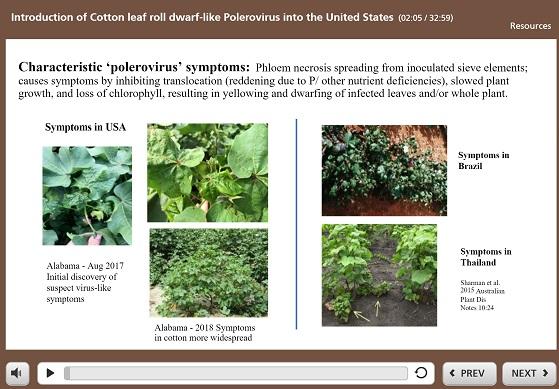
Credit: Plant Management Network and Judith K. Brown
St. Paul, MN (October, 2019)–Cotton blue disease, caused by Cotton leafroll dwarf virus (CLRDV), was first reported in 1949 in the Central African Republic and then not again until 2005, when it was reported from Brazil. In 2017, cotton blue disease was identified in Alabama, marking the first report in the United States.
Plant pathologists discovered foliar distortion and leaf curling and rolling on cotton in six counties in coastal Alabama. They sent samples to University of Arizona plant pathologist Judith K. Brown, who originally suspected the causal agent to be a whitefly-transmitted geminivirus–the only type of virus known to infect cotton in the United States at that time. However, after using the Illumina platform for discovery genomics to conduct next-generation sequencing, Brown determined that the symptoms were characteristic of cotton blue disease.
Characteristic symptoms of cotton blue disease include slowed plant growth and loss of chlorophyll, causing the yellowing or dwarfing of infected leaves and/or the entire plant. The disease also inhibits translocation and results in reddening due to nutrient deficiencies. Symptoms usually do not appear until after full bloom in late August.
To learn more about control options for the disease, Brown researched the management strategies used in Brazil. There, strategies focus on eliminating the reservoir host with weed control and preventing volunteer cotton plant growth; the latter is not a problem in Alabama, where the ground freezes. In Brazil, chemicals are used to control the insects that transfer the disease to the cotton, but this is not an option in the United States. There is currently no recommended course of management for cotton blue disease. Additional research is needed to determine effective management strategies. Brown encourages researchers to focus on genetic resistance.
The full story behind the discovery of cotton blue disease in Alabama is presented in two “Focus on Cotton” webcasts: the 33-minute “Introduction of Cotton leaf roll dwarf-like Polerovirus into the United States: High-Throughput Discovery, Identification, and Genomic Comparisons,” by Judith K. Brown, and the 13-minute “Cotton Blue Disease Caused by Cotton leafroll dwarf like virus: Identification, Symptomology, and Occurrence in Alabama,” by Kathy S. Lawrence.
Both presentations are available through the “Focus on Cotton” resource on the Plant Management Network. This resource contains more than 75 webcasts, along with presentations from six conferences, on a broad range of aspects of cotton crop management: agronomic practices, diseases, harvest and ginning, insects, irrigation, nematodes, precision agriculture, soil health and crop fertility, and weeds. These webcasts are available to readers open access (without a subscription).
The “Focus on Cotton” homepage also provides access to “Cotton Cultivated,” a new resource from Cotton Incorporated that helps users quickly find the most current cotton production information available. These and other resources are freely available courtesy of Cotton Incorporated at http://www.
###
Media Contact
Ashley Bergman Carlin
[email protected]
651-994-3832




